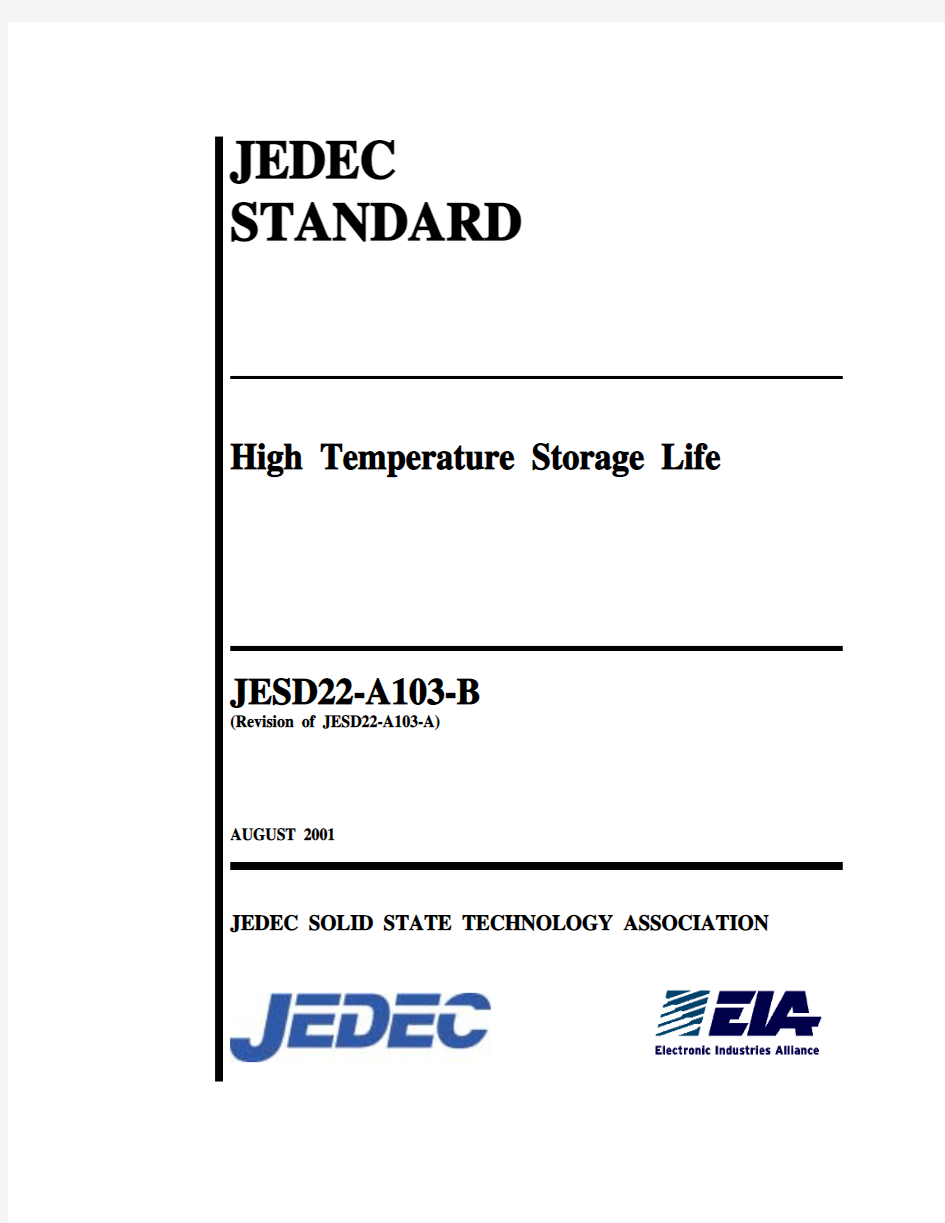

JEDEC
STANDARD
High Temperature Storage Life JESD22-A103-B
(Revision of JESD22-A103-A)
AUGUST 2001
JEDEC SOLID STATE TECHNOLOGY ASSOCIATION
NOTICE
JEDEC standards and publications contain material that has been prepared, reviewed, and approved through the JEDEC Board of Directors level and subsequently reviewed and approved by the EIA General Counsel.
JEDEC standards and publications are designed to serve the public interest through eliminating misunderstandings between manufacturers and purchasers, facilitating interchangeability and improvement of products, and assisting the purchaser in selecting and obtaining with minimum delay the proper product for use by those other than JEDEC members, whether the standard is to be used either domestically or internationally.
JEDEC standards and publications are adopted without regard to whether or not their adoption may involve patents or articles, materials, or processes. By such action JEDEC does not assume any liability to any patent owner, nor does it assume any obligation whatever to parties adopting the JEDEC standards or publications.
The information included in JEDEC standards and publications represents a sound approach to product specification and application, principally from the solid state device manufacturer viewpoint. Within the JEDEC organization there are procedures whereby an JEDEC standard or publication may be further processed and ultimately become an ANSI/EIA standard.
No claims to be in conformance with this standard may be made unless all requirements stated in the standard are met.
Inquiries, comments, and suggestions relative to the content of this JEDEC standard or publication should be addressed to JEDEC Solid State Technology Association, 2500 Wilson Boulevard, Arlington, VA 22201-3834, (703)907-7559 or https://www.doczj.com/doc/ed18867497.html,
Published by
JEDEC Solid State Technology Association 2001
2500 Wilson Boulevard
Arlington, VA 22201-3834
This document may be downloaded free of charge; however JEDEC retains the
copyright on this material. By downloading this file the individual agrees not to
charge for or resell the resulting material.
PRICE: Please refer to the current
Catalog of JEDEC Engineering Standards and Publications or call Global Engineering Documents, USA and Canada 1-800-854-7179, International (303) 397-7956
Printed in the U.S.A.
All rights reserved
JEDEC Standard 22-A103-B
Page 1
TEST METHOD A103-B
HIGH TEMPERATURE STORAGE LIFE
(From JEDEC Board Ballot JCB-01-22, formulated under the cognizance of JC-14.1 Subcommittee on Reliability Test Methods for Packaged Devices.)
1 Scope
The test is applicable for evaluation, screening, monitoring, and/or qualification of all solid state devices.
High Temperature storage test is typically used to determine the effect of time and temperature, under storage conditions, for thermally activated failure mechanisms of solid state electronic devices, including nonvolatile memory devices (data retention failure mechanisms). During the test elevated temperatures (accelerated test conditions) are used without electrical stress applied. This test may be destructive, depending on Time, Temperature and Packaging (if any).
2 Apparatus
2.1 High temperature storage chambers
The apparatus required for this test shall consist of a controlled temperature chamber capable of maintaining the specified temperature over the entire sample population under test.
2.2 Electrical test equipment
Electrical equipment capable of performing the appropriate measurements for the devices being tested, including write and verify the required data retention pattern(s) for nonvolatile memories.
Test Method A103-B
JEDEC Standard 22-A103-B
Page 2
3 Procedure
3.1 High temperature storage conditions
The Devices under test shall be subjected to continuous storage at one of the Temperature Conditions of Table 1.
Table 1 — High Temperature storage conditions
Condition A: +125 (-0/+10) °C
Condition B: +150 (-0/+10) °C
Condition C: +175 (-0/+10) °C
Condition D: +200 (-0/+10) °C
Condition E: +250 (-0/+10) °C
Condition F: +300 (-0/+10) °C
NOTE CAUTION should be exercised when selecting an accelerated test condition since the accelerated temperature used may exceed the capabilities of the device and materials, thereby inducing failures (overstress) failures that would not occur under normal use conditions.
As a minimum the following items should be taken into consideration:
1) Melting point of metals present, especially solder. Degradation of metals including metallurgical interfaces.
2) Package degradation. For example Glass Transition Temperature and thermal stability (in air) of any polymeric materials.
3) Moisture rating of package (per J-STD-020).
4) Temperature limitations of silicon devices. For example: Charge loss in Nonvolatile memories.
The Qualification and Reliability monitoring test conditions have typically duration of 1000 hours per condition B of Table 1 (JESD 47). Other conditions and durations may be used as appropriate.
The devices may be returned to room ambient conditions for interim electrical measurements. Test Method A103-B
JEDEC Standard 22-A103-B
Page 3 3 Procedure (cont’d)
3.2 Measurements
Unless otherwise specified, interim and final electrical test measurements shall be completed within 96 hours after removal of the devices from the specified test conditions. Intermediate measurements are optional unless otherwise specified.
The electrical test measurements shall consist of parametric and functional tests specified in the applicable procurement document. For nonvolatile memories, the data specified data retention pattern must be written initially, then subsequently verified without re-writing.
3.3 Failure criteria
A device will be considered a High Temperature Storage failure if parametric limits are exceeded, or if functionality cannot be demonstrated under nominal and worst-case conditions, as specified in the applicable procurement document. For nonvolatile memories, the specified data retention pattern shall be verified before and after storage. A margin test may be used to detect data retention degradation.
Mechanical damage, such as cracking, chipping, or breaking of the package,(as defined in test method B101 “External visual”) will be considered a failure, provided that such damage was not induced by fixtures or handling and it is critical to the package performance in the specific application.
Cosmetic package defects and degradation of lead finish, or solderability are not considered valid failure criteria for this stress.
4 Summary
The following details shall be specified in the applicable procurement document.
a) Electrical test measurements.
b) Sample size and number of failures (specify zero if none observed).
c) Time and conditions, if other than 1000 hours per condition B.
d) Intermediate electrical test measurements, if required.
e) Nonvolatile memory data retention pattern (for appropriate devices)
Test Method A103-B
JEDEC Standard 22-A103-B Page 4
Test Method A103-B